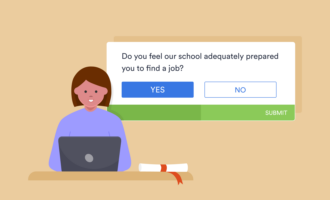What’s the best way to assess your students?
Formative and summative assessments are both crucial tools for measuring student learning. Each serves a specific purpose in the learning process, explains teacher and education writer Tracey Derrell.
But collecting data has often been difficult for teachers. Designing the assessments, extracting the data, and analyzing the information are time-consuming tasks, unless you use the right technology.
Digital tools simplify the process of administering tests and analyzing data, which makes it easier for teachers to assess a student’s progress.
Pro Tip
For an insightful look into the future of higher education, explore “8 Top Trends in Higher Education to Watch in 2024” on Jotform’s blog.
Formative assessments measure progress
When teachers need to assess how well students grasp concepts as the material is being taught, they administer formative assessments. Through these assessments, teachers can recognize where students need help, and then they can adjust their teaching to immediately address those problem areas, notes the Eberly Center at Carnegie Mellon University.
This type of assessment creates a feedback loop between the student and the teacher so they can work together to improve learning.
The great thing about formative assessments is that they are more flexible than summative assessments. You don’t have to administer a typical quiz to gather your data. Teachers can use student reflections, discussion sessions, homework, quizzes, and collaborative activities as formative assessments, says Jordan Catapano, an assistant high school principal in the Chicago area.
Formative assessments: Tailoring lessons based on real-time data
The flexibility of formative assessments makes them perfect candidates for high-tech administration.
For example, Alexis Roesser, English department chair for a high school in Salamanca, New York, advocates using entrance and exit tickets to gauge student progress. An entrance ticket asks about a student’s level of understanding before class begins, while an exit ticket asks students to recap a day’s lesson. Each gives the teacher a quick peek at a student’s current level of understanding.
To administer these assessments, Roesser suggests using discussion forums or shared online surveys to take advantage of the instant insights these platforms provide. The option for using paper and pen is there, but you lose the instantaneous data gathering.
Monica Burns, an educator and founder of ClassTechTips.com, likes to embed questions in her presentations to get instant feedback from students. She creates her presentations in Nearpod, an interactive presentation builder.
If you’ve already built your presentations in another program, you can use clickers, such as iClicker, to record student answers to embedded questions. This allows you to collect immediate data and track individual student progress.
The quicker teachers can gather their data, the better. Technology has made it possible for them to adjust their teaching in real time based on data gathered during a lesson.
Summative assessments measure mastery
Summative assessments are given at the end of a lesson unit or course to measure students’ mastery of the standards. The most common types of summative assessments are end-of-unit or -chapter tests, midterm exams, final exams, state assessments, portfolios of work, and research reports.
In contrast to formative assessments, summative assessments are high-stakes tasks. These are typically graded to tell you whether the student has learned the material. Such assessments are delivered too far down the learning path to be used in making instructional adjustments, explain Catherine Garrison and Michael Ehringhaus, Ph.D., at educational professional development company Measured Progress.
The data gathered from summative assessments, instead, can be used to help guide teacher decisions, such as assigning grades, promotions, graduation, and class credits, writes Kathy Dyer, a manager at assessment company NWEA.
Summative assessments: Moving beyond multiple choice
Technology tools can help teachers get creative with summative assessments while still collecting valuable data to measure mastery.
As part of her summative assessments, English teacher Jayme Cook uses poster-making app Posterini for student projects. The app lets students create virtual posters by cutting and pasting images and text. She also uses The Tweeted Times for students to create an original newsletter of learned materials using their Twitter feeds as content.
Each of these tools puts a different spin on an end-of-unit project.
When going the more traditional route of an exam, teachers can also use digital forms to create, score, and track the data from these exams. The great thing about digital exams is that you can move beyond multiple choice or true/false questions into more creative and interactive questions.
Assessment-building technology company Learnosity explains that some of those potential question types are being used in Common Core digital testing, which includes drag and drop, text and essays, visual questions, and match and order.
These different question types can help students explore their mastery and teachers test their students’ understanding via the most appropriate assessments.
The cumulative nature of summative assessments means teachers don’t need the real-time feedback of formative assessments. Therefore, you can create multifaceted assignments and questions that really test a student’s knowledge. Technology gives you the resources to easily collect and analyze the data from these assessments.
While these types of assessments are very different by design, they both work toward the same goal: measuring student learning. Both assessments are crucial for teachers, and both can be more efficient through the use of technology.
Photo by Helloquence on Unsplash







































































































Send Comment: